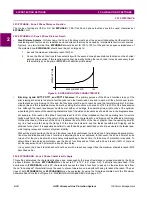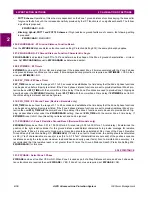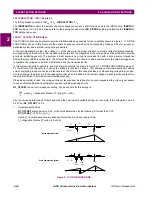
2-26
ALPS Advanced Line Protection System
GE Power Management
2.3 PROTECTION SETTINGS
2 CALCULATION OF SETTINGS
2
604: 50PICKUPFF - 50 Pickup During Fuse Failure
If 50 is made directional and potential is lost to the relay, then directional control will be lost and the 50 function will not pro-
vide any protection. To overcome this drawback, a second setting (50PICKUPFF) provides some backup during a loss of
potential. A 50PICKUPFF setting must always be made and it must always be set at least 25% greater than the maximum
delta three-phase fault current for a fault at either terminal of the line.
605: 50G - Ground Instantaneous Overcurrent
The 50G function can be used in many applications to provide high speed, direct tripping for heavy close-in faults. To use
the ground instantaneous overcurrent trip function, set 50G = YES, otherwise set 50G = NO. See Protection Settings 606
and 607 for further discussion on use of 50G function.
606: 50G_DIRDNL - Directional Control Of 50G
The 50G function can be set to be either directional or nondirectional. Directionality is obtained through the use of the neg-
ative sequence directional functions by requiring operation of the NT (forward looking) function AND non-operation of the
NB (reverse looking) function.
If 50G is made directional, the setting to be made on the function is based on the maximum fault current for a fault at the
remote end of the line. When 50G is made non-directional, then the setting is based on the maximum fault current for a
fault at either end of the line. If the maximum fault current for a fault at either end of the line is approximately the same, then
it is proposed that the 50 function be made non-directional.
607: 50GPICKUP - 50G Pickup Setting
The considerations used to determine the 50G setting depend on whether 50G is nondirectional or directionally controlled.
If 50G is nondirectional, then it must be set not to operate on the worst case external fault at
either end of the line. If 50G is
controlled by the negative sequence directional functions, then it must be set not to operate for the worst case external fault
at the
remote end of the line. In general, directional control should be used when the operating current for a fault behind the
relay location is much greater than the operating current for a fault at the remote end of the line.
50G provides direct tripping for single-line-to-ground faults, and its operating quantity is:
50G
op
=
- 50GRESTNT x
where 50GRESTNT = 0 or 0.3. When 50GRESTNT is set to 0.3, positive-sequence current restraint is used to provide
secure operation during steady state unbalances, error currents, and external faults. The 50G setting is established by first
determining the
maximum positive value of the operating quantity listed above (taking into account the 50GRESTNT set-
ting). 50GPICKUP is then this maximum operate signal plus a margin of 25% of the
value from this same maximum
operate signal.
50GPICKUP =
- 50GRESTNT
×
+ 0.25
×
608: 50GPCKUPFF - Pickup During Fuse Failure
If 50G is made directional and potential is lost to the relay, then directional control will be lost and the 50G function will not
be able to provide any protection. To overcome this drawback, a second setting (50GPCKUPFF) can be made on the 50G
function to provide some backup during a loss of potential. A 50GPCKUPFF setting must always be made and it must
always be set as given above and based on the maximum operating quantity that can be obtained for a fault at either end
of the line.
609: 50GRESTNT - 50G Restraint Setting
50GRESTNT can be set to 0 or 0.3, and it determines whether or not a portion of the positive-sequence current, is used to
restrain the operating quantity,
. The effect of positive sequence current restraint is to make the 50G function more
secure during external faults, steady state unbalances and/or error currents.
610: 51G - Select Ground Time Overcurrent (TOC)
51G can be set to either YES or NO. This setting determines whether the 51G function is in service (YES) or out of service
(NO).
3
I
0
×
3
I
1
×
3
I
0
×
3
I
0
×
3
I
1
×
3
I
0
×
3
I
0
×






























